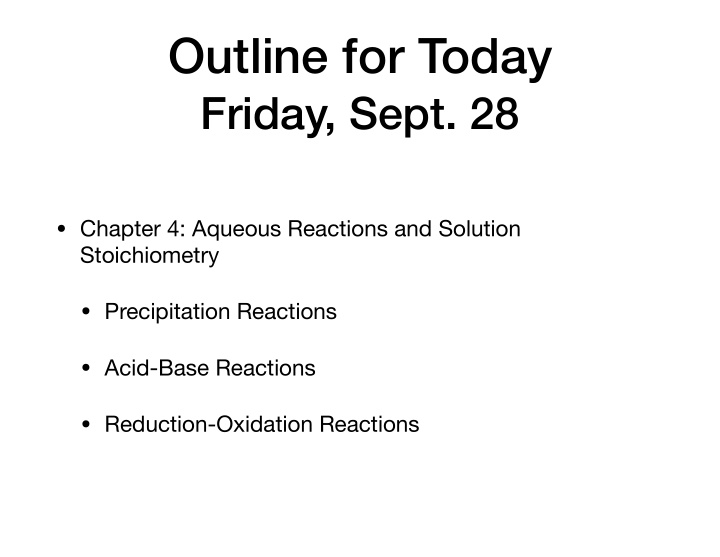



Outline for Today Friday, Sept. 28 • Chapter 4: Aqueous Reactions and Solution Stoichiometry • Precipitation Reactions • Acid-Base Reactions • Reduction-Oxidation Reactions
On your note card, take 2 minutes to write: • Name • What are two di ff erent ways you will study for the exam on Monday ? • What is one topic that you feel good about for the exam? • What is one challenging topic that you will focus on while studying for the exam?
Solubility Rules • Compounds Anion Exceptions containing the NO 3- None following are soluble : CH 3 COO - None With Ag 2+ , Hg 2 2+ , Cl - Cation Exception Pb 2+ With Ag 2+ , Hg 2 2+ , Alkali Metals Br - None Pb 2+ (Group 1A) With Ag 2+ , Hg 2 2+ , I - NH 4+ None Pb 2+ With Sr 2+ , Ba 2+ , SO 42- 2+ , Pb 2+ From Table 4.1 Hg 2
Solubility Rules Anion Exceptions • Compounds + , alkali containing the With NH 4 S 2- 2+ , Sr 2+ , cations, Ca following are 2+ Ba + , alkali NOT soluble : With NH 4 OH - 2+ , Sr 2+ , cations, Ca 2+ Ba With NH 4+, CO 32- alkali cations + , alkali With NH 4 PO 43- cations From Table 4.1
Memorize Table 4.2
Determining Oxidation Numbers 1. Atoms in elemental form: Oxidation number is zero. 2. Monoatomic ion: Oxidation number equals the charge. 3. Oxygen: Usually -2 4. Hydrogen: bonded to nonmetal, usually +1; bonded to metals, usually -1 5. Fluorine: Always -1 6. Other Halogens: Usually -1. Bonded to Oxygen? 7. sum of oxidation numbers for neutral compound is zero, some for polyatomic ion is charge of ion.
Determining Oxidation Numbers Oxidation Number Species Elemental Atoms 0 Monoatomic Ion Charge on Ion “+1 Hydrogen Bonded to Nonmetal Hydrogen Bonded to Metal -1 Oxygen Usually -2 Fluorine -1 Other Halogens Usually -1 Neutral Molecule Sum of Oxidation Numbers is 0 Polyatomic Ion Sum of Oxidation Numbers is Ion charge
Recommend
More recommend